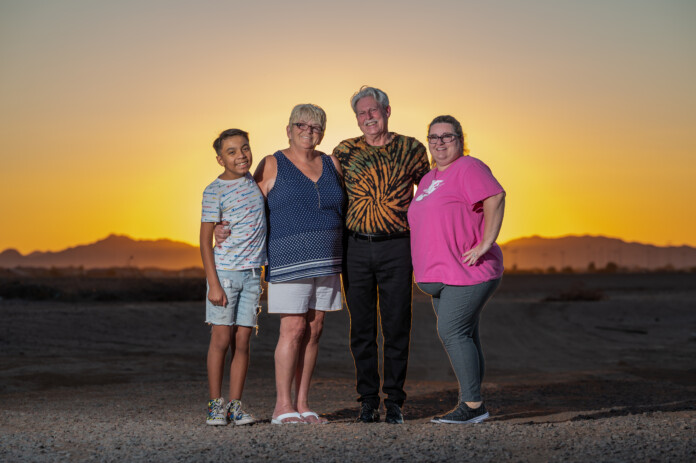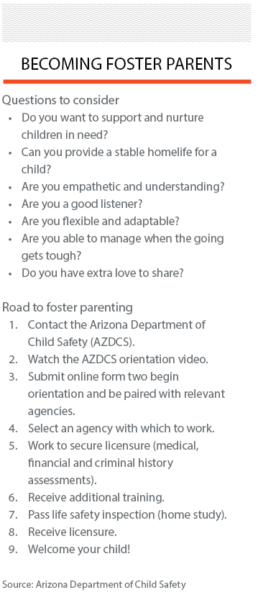
In the Boggs household, there’s seldom a dull moment.
For 34 years, Gary Boggs and his wife, Kitty, have been foster parents, welcoming more than 360 children into their home.
That’s about one new child a month — every month — from 1988 to 2021.
The Boggs — Gary will turn 67 in December and Kitty is 65 — have been married 45 years and have two biological daughters, Shanna and Tiffany. Along the way, they have adopted 10 children into their family.
“We never said no,” Kitty said, referring to calls from foster care agencies. And whether the newcomers to the Boggs’ home were there for a matter of days or years, they were all treated the same.
The Boggs, who moved to Maricopa last year, currently have foster children ages 18, 17, 16 and 12.
“We don’t use the word ‘foster’ when we talk about our children,” Kitty said recently. “They are children. Our children. I will protect any child.”
Tiffany, who lives nearby with her family, confirmed those words.
“Whether biological or not, they never ever referred to a child as a foster child,” she said of her parents. “We were all their children.”
 Troubled youth
Troubled youth
Gary and Kitty Boggs met in Sioux City, Iowa, where she worked in a bar, and he came in to cash his check and have a drink.
“I looked at the bartender” after seeing Gary that day, she recalled, “and said I’m going to marry him someday — and here we are.”
They maintained their foster care license for 33 years in Iowa before moving to Arizona. Gary, who owned a hair salon in The Hawkeye State for nearly 25 years, is back at work cutting hair in a local shop.
The couple’s long commitment to fostering children began in 1988, when the boyfriend of an ex-sister-in-law was mistreating Kitty’s niece and nephew. What started as a family-care situation evolved to the state of Iowa requiring a foster care license.
“The next thing you know, the state calls with this emergency or that emergency — and we’ve got eight kids in our home,” Kitty said.
At one point, their home had five twin beds and five dressers in one bedroom. Later, state guidelines limited the number of children allowed at one time based on a home’s size.
The circumstances that brought the children to the Boggs’ home were often heartbreaking.
“We would get some on a Friday night,” Gary pointed out, “when mom and dad were in a bar fight and the kids were at the babysitter. We may have them for three days because (the parents) would get in front of a judge by Monday or Tuesday, while other deadbeat parents did not try at all to get (their children) back.”
There were two 6-month-old babies addicted to crack. And three lice-infested children found alone in the middle of the night by a park ranger. And the little girl who survived a high-speed car chase.
“It was everything you can imagine,” Tiffany acknowledged.
Creating a family
The Boggs’ first adoption came in 1996. Gary confessed he might not be able to remember all the adopted children’s names, but he, Kitty and Tiffany quickly rattle off the list of 10.
No matter the situation, newcomers to the Boggs’ home received the same message.
“One of the first things I would address with them,” Kitty said, “is that you can’t make me not love you. No matter what you do, I won’t quit loving you.”
If trouble ensued, the kids were required to write essays from the Bible. “And one thing we always did was (go to) church,” Kitty added.
Regular family meetings on Sunday nights allowed everyone in the house to share their problems and seek solutions. All got a vote on the preferred destination for the summer vacation.
With permission required to take the adopted children outside the state of Iowa, Kitty said they worked closely with a lot of biological parents.
Laundry and kitchen chores are shared by everyone in the household. When one foster child complained there was no food in the home, the family received a special visit.
“The guardian ad litem showed up and said I need to look in your refrigerator and freezer,” Gary recalled. “There was plenty of food. The problem was there was no junk food that they were used to eating.”
Kitty’s bedroom closet served as a food pantry for snacks and other treats.
This past May was the first time they didn’t have someone at home graduating from high school. They had four seniors in their first year of fostering.
“They each had their own graduation party, Kitty recalled. “We had a party each Sunday afternoon in the month of May that year.”
The acts of kindness were returned.
An adopted daughter, now living in Iowa with her husband and three children, bought an airline ticket for Kitty to come see them in late September. And then, over the years, there were special tributes on Mother’s Day.
Sara, 18, said COVID-19 made it impossible in 2020 for a meal out to celebrate.
“We decided to bring Olive Garden to Mom,” she said. “We made menus, and we sent Tiffany to Walmart to get all the supplies for chicken alfredo and brownies. We put on a whole act as waitresses.”
“They dressed in black and white and put napkins over their arms,” Kitty said. “It was all their idea, their expense. It was absolutely fabulous. I will never ever forget that day.”
Another Mother’s Day was marked with a scavenger hunt to different places around town and the grandchildren wearing T-shirts matching Kitty’s.
Extreme circumstances
Over the years, the Boggs witnessed changes in the children coming into their home.
“We started getting the harder kids,” Kitty said.
Gary said when they first got into it, the kids often were suffering at the hands of their parents.
“By the time we were halfway through, the parents couldn’t handle the children and pushed them out,” he said.
But the youths’ difficult circumstances in life were always top of mind.
“I was always amazed what these kids had experienced,” Gary continued. “I always told them you’re not a victim anymore. ‘You’re a survivor, so let’s not play the victim.’”
Kitty would share her own experiences to show her understanding and support.
“I was a severely abused child myself,” she said. “I always told the children my life story. I always let these kids know that I knew what they were going through.”
Moving into a loving home has helped many of their foster children. Even if it meant some trying times for the family from those who didn’t seem to appreciate their generosity.
One teen became drunk, escaped police and drove a vehicle into their house. Kitty was standing on the porch when the crash occurred, and Tiffany said a deadly tragedy was averted by just a few inches. The family was out of its home for six months.
When one of their foster girls decided she wanted to run away, she tied the bed sheets together and let them out the window — but forgot to tie the other end to the bed. She fell and broke her leg.
Still, Kitty was always looking to brighten the lives of children — even if she had to find them herself.
Once, when called to pick up one child from a foster center, she noticed “a tiny little adorable girl sitting on the couch crying.” The 4-year-old was roommates with the girl going to the Boggs’ home. Kitty went to work the next day to find out who the crying girl was. It was near Christmastime, and “I said, ‘Santa Claus has to come (for her).’”
The little girl was brought home for Christmas.
“All she did Christmas morning,” Kitty remembered, “was sit in the middle of the living room floor and cry (out of happiness). She was so overwhelmed. She didn’t know what to play with first.”
That holiday joy helped the young girl forget her distressing situation, Tiffany recalled.
“What was really sad was, I talked to her and she said, ‘Oh, my mom was really smart. Dad tried to slash her from here to here (motioning across her throat), so she threw the TV on his foot.’
“For me, a 4-year-old saying that. I was like, ‘Oh my gosh!’”
Examining the system
After three-plus decades in the foster care system, family members understand its ins and outs.
“It’s supposed to be temporary, but that’s the furthest thing from reality,” Tiffany said.
Gary noted the stated intent of unification is often a fallacy.
Some children lived with the Boggs for as long as five years but were never adopted because their biological parents did not relinquish their rights.
“The minute they turn 18, the state is done with them,” Kitty explained. “We got many apartments set up, got kids ready to be on their own.”
Maintaining the home was often a balancing act.
“Many times, all would conform and get along. Then they would put a new child in, and all hell would break loose,” Gary said.
Tiffany said she knew what mistakes to avoid from watching the foster children make them. And some of her many brothers and sisters failed to appreciate their foster home with the Boggs.
“For me, there were some adopted kids that if I saw them in the store, I would go the other direction,” she admitted. “Then there were some foster kids that I still have the greatest relationship with.”
“I would say we had many more good times than bad times,” Kitty said, simply.
Difficult decision
With many firsthand experiences to share with others, the Boggs were very active in the Iowa Foster & Adoptive Parents Association. In the early days, they were among a small set of parents who ran the organization on a volunteer basis.
Gary taught classes for prospective foster parents through a vocational college, presenting the realistic side of the curriculum to counterbalance a social worker who tended to glorify the process. Never negative in his approach, Gary made it clear that being a foster parent “was not all peaches and cream,” Kitty explained.
The challenges were many. But one circumstance clearly stands out.
“The hardest moments were telling kids their parent had died,” said Kitty. In one case, they had to tell a child their mother had committed suicide.
With many difficult situations arising over the years with foster children, one might think it was an easy choice to move on after so many years of giving back. That was far from the case.
“When we decided to move to Arizona, I didn’t know if I was ready to throw in the towel on foster care,” Kitty admitted. “It was a hard call to DHS (Department of Human Services). We had made great friends and acquaintances with the social workers.”
A certified nursing assistant, Kitty has done some in-home health care. “I’m a caretaker, and I can’t quit caretaking.”
Asked about the prospects of a quieter home down the line with no children, Gary said he has never thought about it.
Kitty has considered the possibility — and not surprisingly, dismissed it.
“I figure I have six more years of having a child under my roof,” she calculated. “But I’m thinking I’m never going to have an empty nest because I’m going to be grandma (Tiffany’s children currently come to the Boggs’ house after school until their parents are home from work) and great grandma continuously. My daughters and granddaughters will keep my arms full for me.”
This content was first published in the November edition of InMaricopa magazine.


![Alleged car thief released without charges Phoenix police stop a stolen vehicle on April 20, 2024. [Facebook]](https://www.inmaricopa.com/wp-content/uploads/2024/04/IMG_5040-218x150.jpg)
![Locals find zen with Earth Day drum circle Lizz Fiedorczyk instructs a drum circle at Maricopa Community Center April 22, 2024. [Brian Petersheim Jr.]](https://www.inmaricopa.com/wp-content/uploads/2024/04/PJ_3922-Enhanced-NR-218x150.jpg)










![Alleged car thief released without charges Phoenix police stop a stolen vehicle on April 20, 2024. [Facebook]](https://www.inmaricopa.com/wp-content/uploads/2024/04/IMG_5040-100x70.jpg)
![Locals find zen with Earth Day drum circle Lizz Fiedorczyk instructs a drum circle at Maricopa Community Center April 22, 2024. [Brian Petersheim Jr.]](https://www.inmaricopa.com/wp-content/uploads/2024/04/PJ_3922-Enhanced-NR-100x70.jpg)
